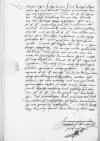Aus E(wer) F(urstlichen) D(urchlauch)t cf. Albrecht I von Hohenzollern-Ansbach to Ioannes DANTISCUS Königsberg, 1539-04-15, CIDTC IDL 4949⌊schreÿbencf. Albrecht I von Hohenzollern-Ansbach to Ioannes DANTISCUS Königsberg, 1539-04-15, CIDTC IDL 4949⌋, datum(m) Königsberg (Królewiec, Mons Regius, Regiomontium), city in Ducal Prussia, on the mouth of the Pregel (Pregoła) river, capital city of Ducal Prussia; today Kaliningrad in Russia⌊KunsbergKönigsberg (Królewiec, Mons Regius, Regiomontium), city in Ducal Prussia, on the mouth of the Pregel (Pregoła) river, capital city of Ducal Prussia; today Kaliningrad in Russia⌋ den XV dits monds, das wir jestrigs thags erhalthen, / hab wir E(wer) F(urstlichen) D(urchlauch)t meÿnung was dÿ ratificacion Christian III of Oldenburg (*1503 – †1559), 1534-1559 King of Denmark and Norway, 1523-1559 Duke of Holstein and Schleswig; son of Frederick I of Oldenburg, King of Denmark, and his first consort, Anna of Brandenburg⌊ko(nigliche)r wird zu Dennemarck(en)Christian III of Oldenburg (*1503 – †1559), 1534-1559 King of Denmark and Norway, 1523-1559 Duke of Holstein and Schleswig; son of Frederick I of Oldenburg, King of Denmark, and his first consort, Anna of Brandenburg⌋ uber dÿ sum(m)a gelds etc. belangt / und wÿ dÿ E(wer) F(urstliche) D(urchlauch)t dem edlen, ernfesten hern Achatius von Zehmen (Achacy Cema) (*ca. 1485 – †1565), 1517-1531 Chamberlain of Pomerania, 1531-1546 Castellan of Gdańsk (Danzig), 1545-1546 Voivode of Kulm (Chełmno), 1546-1565 Voivode of Marienburg (Malbork) (SBPN 1, p. 194-195; ORACKI 1984, p. 38-39; Urzędnicy 5/2, p. 198; PSB 4, p. 325-326)⌊danctzker castellannAchatius von Zehmen (Achacy Cema) (*ca. 1485 – †1565), 1517-1531 Chamberlain of Pomerania, 1531-1546 Castellan of Gdańsk (Danzig), 1545-1546 Voivode of Kulm (Chełmno), 1546-1565 Voivode of Marienburg (Malbork) (SBPN 1, p. 194-195; ORACKI 1984, p. 38-39; Urzędnicy 5/2, p. 198; PSB 4, p. 325-326)⌋ under hochgedachter ko(nigliche)r wird grossem insigel geantwurtt, / domit uff negster Sigismund I Jagiellon (Zygmunt I) (*1467 – †1548), King of Poland and Grand Duke of Lithuania (1506-1548); Duke of Głogów (Glogau) (1499-1506), Duke of Opava (1501-1506), Governor of Silesia (1504-1506); son of King Kazimierz IV Jagiellon and Elisabeth of Austria⌊ko(nigliche)r m(aieste)tSigismund I Jagiellon (Zygmunt I) (*1467 – †1548), King of Poland and Grand Duke of Lithuania (1506-1548); Duke of Głogów (Glogau) (1499-1506), Duke of Opava (1501-1506), Governor of Silesia (1504-1506); son of King Kazimierz IV Jagiellon and Elisabeth of Austria⌋, u(nseres) a(llergnedigsten) hern, Council of Royal Prussia the most important local authority in Royal Prussia. It consisted of two bishops (of Ermland (Warmia), who served as the Council’s president, and of Kulm (Chełmno)), three voivodes (of Kulm, Marienburg (Malbork), and Pomerania), three castellans (of Kulm, Elbing (Elbląg), and Gdańsk (Danzig)), three chamberlains (of Kulm, Marienburg, and Pomerania), and representatives of the three Great Prussian Cities – Gdańsk, Thorn (Toruń), and Elbing (ACHREMCZYK 2016, p. 17-18)⌊rethenCouncil of Royal Prussia the most important local authority in Royal Prussia. It consisted of two bishops (of Ermland (Warmia), who served as the Council’s president, and of Kulm (Chełmno)), three voivodes (of Kulm, Marienburg (Malbork), and Pomerania), three castellans (of Kulm, Elbing (Elbląg), and Gdańsk (Danzig)), three chamberlains (of Kulm, Marienburg, and Pomerania), and representatives of the three Great Prussian Cities – Gdańsk, Thorn (Toruń), and Elbing (ACHREMCZYK 2016, p. 17-18)⌋ Diet of Poland ⌊thagfarthDiet of Poland ⌋ / dÿ verige wider geben solde werden etc., wor ÿnne vor unser person, / auch an zweÿffel der andern hern, / nichts sol nach bleÿbenn, / domit E(wer) F(urstliche) D(urchlauch)t beger und wÿllenn, / nemlich so es auch dÿ bÿllicheit furdert, / genugen muge gescheen. /
Hie beÿ, wÿ uns E(wer) F(urstliche) D(urchlauch)t bericht, / das dÿ im kortzen uns etliche handlung(en) und schrÿfften wollen zcu stellen etc., seÿ wir erbottig, / und uns gern woln gebrawchen lassen / so weÿt unser slecht vorstandt reÿcht, / wÿlferig und gefellig zcu sein, / dan E(wer) F(urstliche) D(urchlauch)t, / in der gunst wir uns befelhen, / vÿl freuntlicher dinst, / und was wir sonst der selbten zu wolgefallen tzu thunn vormugen, / seÿ wir gentzlich geflÿssen. /
 GStA PK, HBA, C1, No 564 2 unnumbered
GStA PK, HBA, C1, No 564 2 unnumbered
 GStA PK, HBA, C1, No 564 1 unnumbered
GStA PK, HBA, C1, No 564 1 unnumbered

